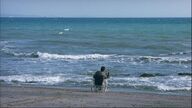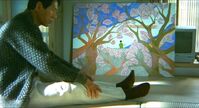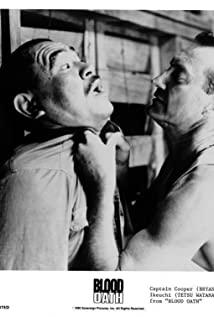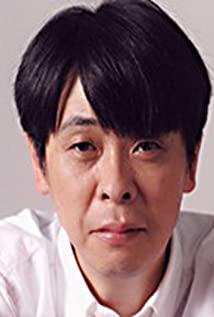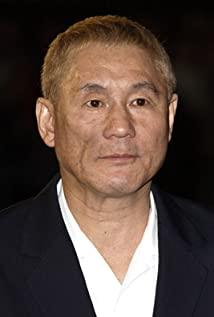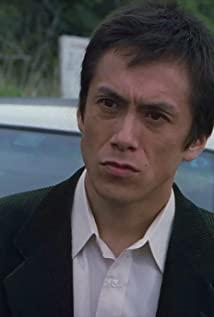Many people must be familiar with Takeshi Kitano. His lighthearted comedy "Kiujiro's Summer" is very famous in China (it seems that the soundtrack is even more famous than the movie). one. "Hana" is the seventh film of Takeshi Kitano. After seven films were filmed, Takeshi Kitano made his own feelings. Some people say that "Hana" is the culmination of the previous films. The film won the Golden Lion Award at the Venice Film Festival in 1997. This is the second time after Akira Kurosawa's "Rashomon" and Inagaki's "Life That Can't Be Released" after nearly 40 years. A small climax was set off, which naturally caused quite a stir, and Kitano Takeshi became the most important director since the 1990s. In fact, Kitano Takeshi has not studied film, and started his career as a film actor from "Merry Christmas, Mr. Lawrence" by Nagisa Oshima, and he was a comic actor before this. His debut film "Ferocious Man" was originally only starring him, but the original director Fukasaku Shinji didn't have time, so he was replaced by Kitano Takeshi, who directed and acted. the road. "Hua Huo" tells the story of a bad luck police officer Xi, whose wife is terminally ill, has a short time, and suffers from the pain of losing her daughter. Later, colleagues were shot one after another. One was paralyzed in the lower body and the other was killed in the line of duty. Xi thought it was his fault and fell into deep self-blame. In order to cure his wife's illness, he borrowed usury loans from the gangsters, and the gangsters forced the debts. The police officer in the west seemed to have met the uncertainty of the future, so he robbed the bank as a policeman and spent the last time with his wife. A car of people, followed by police colleagues, arrived, and the matter came to light. In the end, the couple committed suicide by the sea. The tone of the film is heavy, and Hisaishi lets the melancholy soundtrack complement the film. Heavy yet warm, with a little humor from time to time, and violence at every turn, these are the charms brought by the multi-faceted nature of Takeshi Kitano's films. The first set of shots In an interview, Takeshi Kitano said that the closest standard in his mind is the scene where fireworks start the parking lot. This group of 10 shots strongly reflects Kitano’s own lens language-fixed camera position, static picture, A little comic-like effect, such a capable and concise lens is the best state in Kitano Takeshi's mind. And in terms of rhythm, Kitano Takeshi also grasped just right, the sky shot (3 seconds), the blue-clothed boy close-up (5 seconds), the western police officer close-up (7 seconds), the long shot (3 seconds), followed by a very short punch (1 second) close-up of blue clothes (1 second), car wash (6 seconds). There is a strong contrast between the meaningful staring at the front and the flashing punching process, accompanied by exaggerated punching sound effects, but omitting the punching picture. A powerful visual effect. Violence Aesthetics The films of Takeshi Kitano have to mention violence, and he is the representative figure of today's violent aesthetics. Why is there violence? Takeshi Kitano claimed to be from what he saw and heard in his childhood. He admitted that he was a timid person, and the violent scenes in his childhood left him fresh in his memory, which made him have a special feeling for violence. Takeshi Kitano has his unique interpretation of violence. Unlike Quentin's ready to go, cool scenes and blood spray, Kitano's violence is explosive, coming and going in a hurry. Takeshi Kitano often uses a single move like a martial arts master. For example, in "Fireworks", the chopsticks are inserted into the eyes, the stones are slapped in the face, and the cigarette butts are hot. Kitano's preemptive strikes make the opponent overwhelmed. In many cases, Kitano does not directly show the violent process, but points the camera at the bystander, and the audience only hears the exaggerated beating sound. From the one-punch attack at the beginning of the film to the last two shots, as well as the second duel in the parking lot, Takeshi Kitano borrowed the close-up of shadows and bystanders. The occurrence provides another possibility, and there is some playfulness and helplessness in the violence. Cruelty and warmth Takeshi Kitano's violence is not pure violence, just like the police officer Nishi in "Hanawa", he has two sides. He treats the underworld without mercy, and he treats his wife and colleagues with a delicate and warm side. This is not just in Takeshi Kitano's films, it is a kind of emotion peculiar to the Japanese, the so-called "chrysanthemum and sword" contradiction. Kitano said: "It's like the pendulum of a clock, swinging between cruelty and warmth, and the pendulum swing should be balanced. With warmth, there must be violence, so as to release the potential energy of the pendulum." Warm and violent, this is a helpless choice, and the inner contradiction makes him taciturn. True love is not embarrassing even if there is no language, there is almost no conversation between husband and wife, but there is laughter. The trip in the second half of the film is warm and beautiful, and the rise of fireworks brings the film to a climax. The happy time is very short like fireworks. The happy time is broken again and again, and finally ends with the arrival of the police, and the warmth ends with cruelty. Taking pleasure in hardships Takeshi Kitano was born as a comedian. Almost all of his movies are scripts written by him. Naturally, he will not miss the opportunity to display his funny talents. The uncle who repaired the car in "Fireworks" had a small accident on a trip with his wife. The drivers of , are all humorous jokes in the movie. According to Kitano Takeshi, he wants to use comedy to adjust the tragedy, and there will be comedy little devils to interfere with him when filming. The moderate comedy element of Takeshi Kitano has also become the style of his films, and his films have become more diversified. Many times, we cannot locate Takeshi Kitano's films. He also emphasized that he did not want the film to follow a certain genre. go. The sea and suicide There are some metaphors that often appear in Takeshi Kitano's films, and the sea is one of them. From "That Summer, The Peaceful Sea", "Sonata" to "Fireworks", the sea has appeared, and Takeshi Kitano often points the camera at the sea. In Kitano Takeshi's view, the sea means suicide. When he was at the seaside, he would dream of walking into the sea in order to get death. He brought this imagery into the movie. The male protagonist of "That Summer, Tranquil Sea" was caught in the waves and drowned. "Sonata" committed suicide with a gun on the path by the sea. In "Fireworks", the husband and wife were in Suicides on the beach, the tragic endings and the inherent connection between them, make Kitano's film meaningful. There is a suicide complex in Japanese cultural tradition. Suicide is a way of apology and self-sublimation. The masters of Japanese film history often use movies to analyze suicide culture. Kitano has inherited this well. The cherry blossoms and the bright red word "self-determination" in some of the paintings (all by Takeshi Kitano) that appear in the film are hints at the end of the film's suicide. Epilogue There is a girl flying a kite at the end of the film, and the kite also seems to be a metaphor here. Takeshi Kitano took the kite for the girl, but he pulled off the kite's wings as a prank. At the end, I was immersed in the sad song "Thank You...For Everything". The husband and wife sat on the beach silently, "Thank you, I'm sorry". The wife's only line made the film's moving index further increase. Finally, the camera zooms out and slowly rises, the music reaches a climax, a panning pan, the camera turns to the sea, the music stops abruptly, two crisp gunshots, the sound of waves, and the close-up of the girl ends. The last set of shots is quiet and beautiful. Takeshi Kitano depicts death so quietly. This is Takeshi Kitano's aesthetics of violence - poetic violence.
View more about Fireworks reviews



